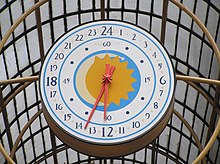
The modern 24-hour clock is the convention of timekeeping in which the day runs from midnight to midnight and is divided into 24 hours. This is indicated by the hours (and minutes) passed since midnight, from 00(:00) to 23(:59), with 24(:00) as an option to indicate the end of the day. This system, as opposed to the 12-hour clock, is the most commonly used time notation in the world today,[A] and is used by the international standard ISO 8601.[1]
A number of countries, particularly English speaking, use the 12-hour clock, or a mixture of the 24- and 12-hour time systems. In countries where the 12-hour clock is dominant, some professions prefer to use the 24-hour clock. For example, in the practice of medicine, the 24-hour clock is generally used in documentation of care as it prevents any ambiguity as to when events occurred in a patient's medical history.[2]
Cite error: There are <ref group=upper-alpha> tags or {{efn-ua}} templates on this page, but the references will not show without a {{reflist|group=upper-alpha}} template or {{notelist-ua}} template (see the help page).
- ^ ISO 8601:2004 – Data elements and interchange formats – Information interchange – Representation of dates and times (3rd ed.). 2004.
- ^ Pickar, Gloria D.; Graham, Hope; Swart, Beth; Swedish, Margaret (2011). Dosage calculations (2nd Canadian ed.). Toronto: Nelson Education. p. 60. ISBN 9780176502591.